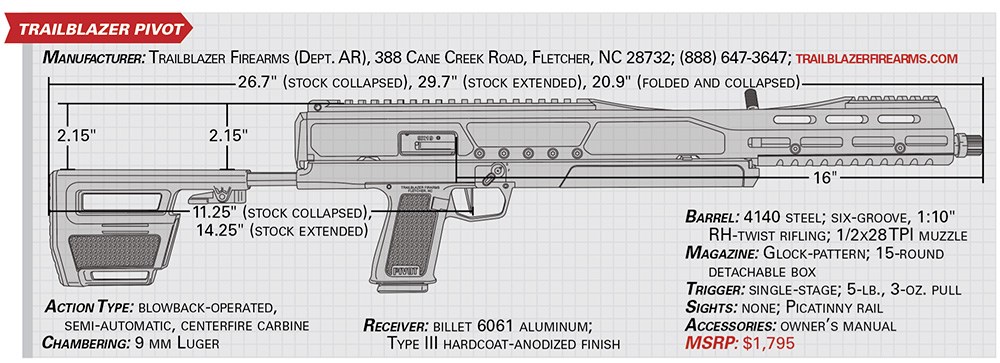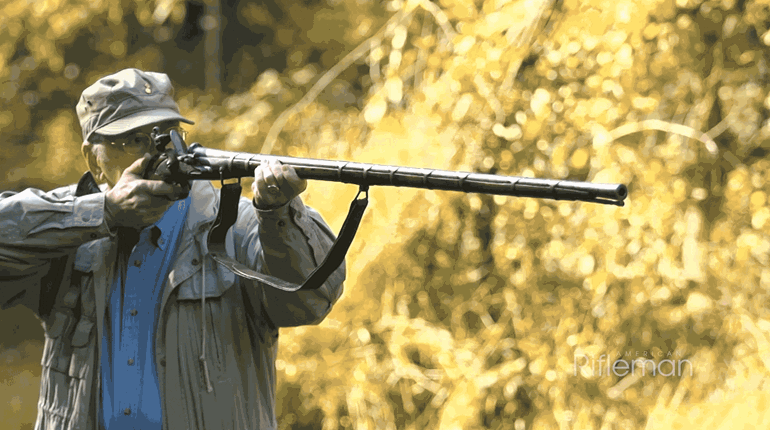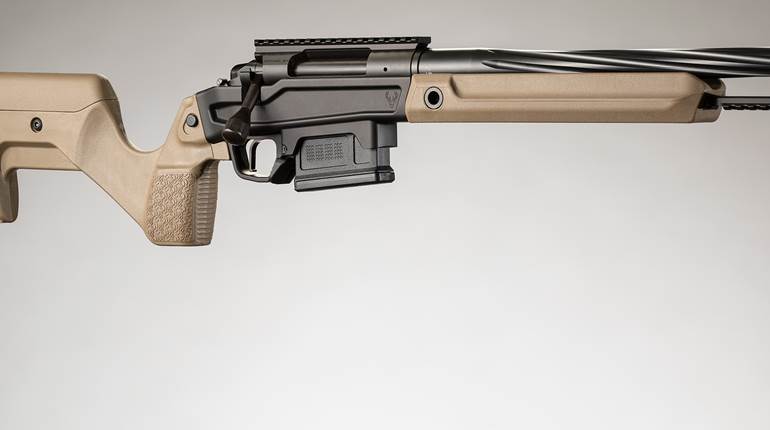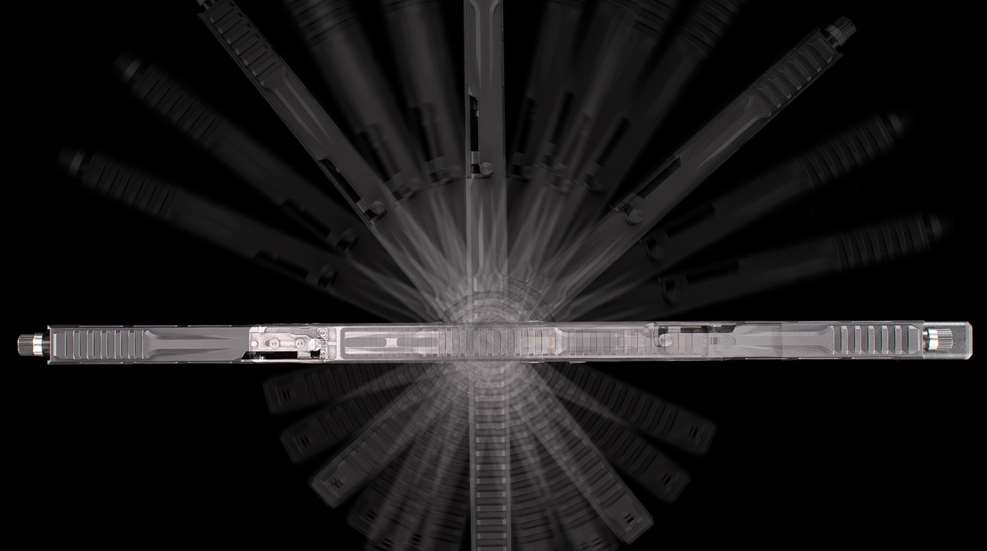
In 2010, Aaron Voigt, the founder of Trailblazer Firearms, was watching television in a hotel room when he saw a program that featured a .380 ACP submachine gun. It was unusual in that it could be folded up to roughly the size and shape of a briefcase. Although the gun was technically interesting, it was not a commercially viable option due to the National Firearms Act (NFA) of 1934, which restricts the ownership of full-automatic firearms and “any other weapons” (AOWs)—including guns disguised to look like ordinary objects such as pens, wallets and walking sticks.
But the program sparked Voigt’s imagination and prompted him to ask the question: “What is the smallest I could make a gun that is still practical and that would conform to standard handgun laws?” Using his hotel room’s credit-card-sized key card as a template, he traced an outline on a piece of paper. The tracing was then divided in half, and he began sketching the internal mechanism of what would eventually become the folding LifeCard rimfire pistol (see americanrifleman.org/lifecard).
Working with a local machine shop, Voigt spent the next few years building a functioning prototype of his new handgun. It was during this time that he also started designing what would become the folding Pivot pistol-caliber carbine (PCC), which is the subject of the evaluation that follows. Early on, the Pivot was going to be chambered in .22 Long Rifle, like the LifeCard, but Voigt eventually settled on a more potent and reliable 9 mm Luger configuration. As a dyed-in-the-wool fan of the Glock 19 pistols, it was a natural choice to configure his carbine to accept Glock magazines.

The inspiration for the Pivot was driven by the ATF’s waffling regarding large-format pistols fitted with stabilizing wrist braces. Voigt was interested in making a carbine that was compact in size and could be easily deployed from a vehicle or a bag, like a braced pistol. However, it was around this time that the ATF ruled that pressing a braced pistol to one’s shoulder “converted’ it into a short-barreled rifle (SBR), making it subject to NFA regulations. To avoid the legally muddied waters of braced handguns, Voigt opted instead to focus on another folding configuration.
“I have been fascinated with portable and packable firearms for many years,” he said. “I thought of a unique way to fold up a rifle that would allow it to be shorter, but not any wider or taller. There were many design challenges along the way, but having no formal training in either design or engineering, I had to rely on my passion for design in general, and firearms in particular.”
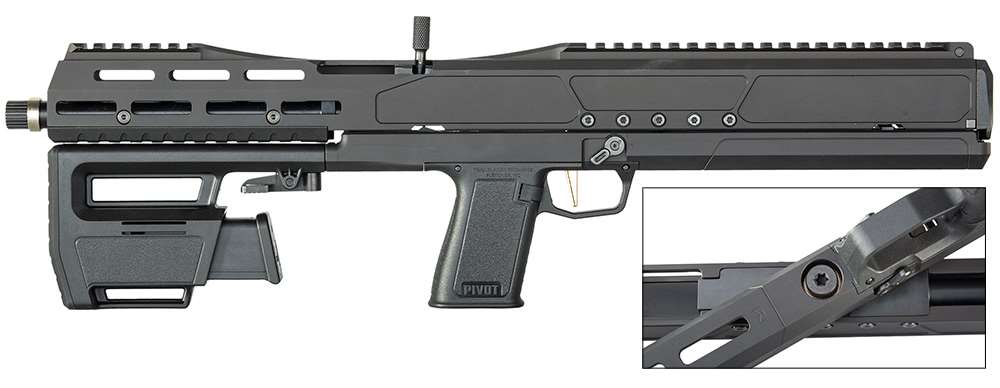
Voigt said he placed several challenging constraints on the design at the outset: “One of my favorites is the overall feel and size of the Pivot, especially the flat profile thickness being the same as a Glock 19 slide. Ultimately, though, the greatest satisfaction comes from having others shoot this new gun and, of course, their reaction to seeing it pivot around for the first time.”
In 2014, a utility patent was awarded for the Pivot which, in turn, led to the founding of Trailblazer Firearms in Asheville, N.C., that same year. The company chose to launch the LifeCard folding pistol as its first product in 2017. It sold well and established Trailblazer as a maker of unusual and innovative firearms. This allowed the Pivot’s development to continue over the next few years.
Before the Pivot was publicly announced in September 2021, I had the opportunity to handle a 3D-printed mockup. It was intriguing, to say the least. When the prototype was unveiled at the 2022 SHOT Show in Las Vegas, Nev., it demonstrated that the concept was fully fleshed out and ready for the market. Production began in September of that year, with the first guns leaving the factory just a few weeks later.
The Pivot is a direct-blowback-operated semi-automatic chambered for 9 mm Luger pistol cartridges. Technically speaking, it can be considered a takedown rifle that employs an upper and lower receiver set (the lower being the serialized component); however, the platform follows an unusual methodology for making its footprint more compact. While most takedown rifles are outfitted with barrel assemblies that either separate from the receiver or are hinged to it, the Pivot’s upper rotates 180 degrees on the lower to face the same direction as the shoulder stock. Turning the upper and collapsing the stock shortens the Pivot’s overall length from 29.7" to 20.9".
It’s worth noting here that bringing the Pivot’s design to fruition required the development and production of nearly all proprietary parts. Although it is not unduly complicated, the only pieces shared with other firearms are the Glock Gen4/Gen5 magazine catch, the catch spring and the tapered muzzle washer adapter, which is made by Q. The remaining 99 percent of the gun consists of proprietary components produced specifically for this model by Trailblazer. It is an impressive effort on the company’s part considering how many guns on the market today borrow from, or are outright clones of, existing models.
The Pivot’s upper and lower are milled from billets of 6061 aluminum and treated with a matte-black Type III hardcoat-anodized finish. The lower’s handguard, pistol grip and shoulder stock are molded from impact-resistant polymer. This gives the Pivot an unloaded weight of 5 lbs., 6 ozs., including the empty 15-round Glock magazine that ships with the carbine. Along its entire length, the gun is only 1.15" wide, which is about the same width as many popular striker-fired pistol slides. With its slim, smooth, snag-free profile and a height of 5.9", the folded Pivot can be tucked comfortably into a variety of smaller storage spaces, cases and packs.
The Pivot does not ship with a sight system installed. Instead, the monolithic upper features two integral Picatinny optics rails. A 2.75", six-slot rail is located above the muzzle with the second 8", 19-slot rail situated at the rear. The rails are configured to be compatible with AR-15 sighting systems including magnified riflescopes, micro red-dot optics and backup iron sights.
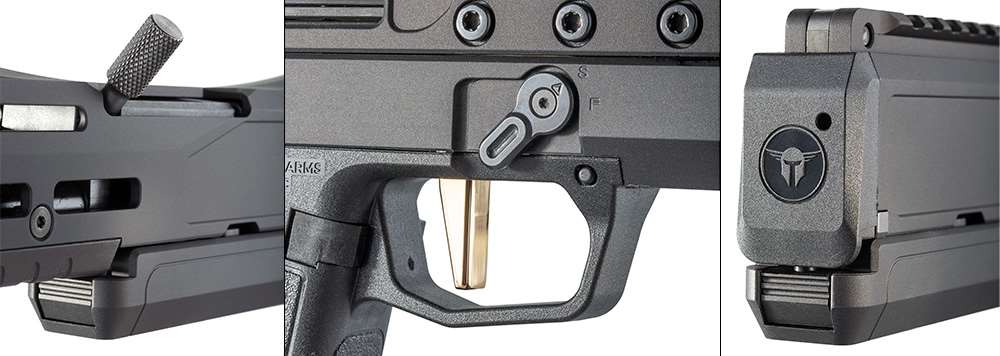
The 16"-long barrel is turned from 4140 steel. It is button-rifled at a 1:10" right-hand twist rate and treated with a black-nitride finish. The muzzle is threaded 1/2x28 TPI to accept a variety of 9 mm-compatible muzzle devices including compensators, brakes and sound suppressors. A knurled thread protector and a suppressor adapter washer are provided. On each side of the vented handguard are four M-Lok accessory slots, and a removable 5.9"-long, textured, glass-filled-nylon plate is secured to the underside of the barrel using a set of six button-head screws.
Like the barrel, the bolt assembly is machined from 4140 steel and treated with a nitride finish. The knurled, non-reciprocating charging handle is located between the front and rear sight rails. It traverses a 2.5" slot cut into the top left corner of the upper. With the bolt forward in the closed position, the charging handle leans out from the receiver at about a 45-degree angle. Pulling the handle all the way back and tipping it up into a vertical position locks the bolt open. This charging handle configuration has two distinct advantages. First, it allows for easy visual or manual verification of the bolt’s position.
Second, when loading the carbine, the handle can be “slapped,” H&K-style, to speed up the chambering process. The ejection port is located on the left side of the upper, just above the pistol grip. The back end of the upper is fitted with a sliding polymer cap that can be removed to provide access to the inner workings for routine cleaning.
The fore-end of the lower contains a grooved aluminum button. Depressing it releases the upper assembly to pivot into either the folded or firing position. A thoughtful touch to the design is an upper that can rotate either clockwise or counterclockwise, depending on the operator’s preferences; this works in conjunction with the carbine’s bilateral external controls to make it accessible to both right- and left-handed shooters.
The flat, bottom edge of the receiver, between the release button and the trigger guard, has two more M-Lok slots to accommodate accessories including laser sights, light modules, bipods and vertical grips. The bilateral, short-throw safety selector levers are positioned just above the trigger guard. Fitted closely to the receiver, using the trigger finger, they swing down into the Safe position and up into the Fire position. Although the safety levers are flat and relatively small to complement the rifle’s no-snag configuration, the “S” and “F” markings on the receiver could stand to be larger and easier to see for those of us who use corrective lenses.
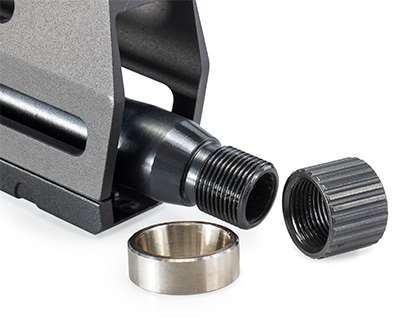
The one-piece, glass-filled-nylon trigger guard and pistol grip are secured to the lower receiver using a pair of round frame pins. Although this portion of the gun looks as if it could have been trimmed off of a striker-fired pistol, it has a unique, straight-grip profile with light texturing and a frontstrap without finger grooves. The textured Gen4/Gen5 magazine release button arrived configured for right-handed operation, but it can be reversed just like the buttons installed on Glock pistols.
The flat-faced, single-stage, 6061-aluminum trigger is treated with a polished, gold-tone PVD finish. The trigger’s feel is comparable to, but not quite the same as, that of a striker-fired pistol. The trigger of the Pivot evaluated here exhibited a firm resistance before breaking cleanly at 5 lbs., 3 ozs.; the total arc of travel was 0.35" with a smooth but slightly mushy feel. The trigger reset produces an audible and tactile “click” about two-thirds of the way back toward the forward position.
The proprietary, two-position, polymer shoulder stock slides back and forth along a narrow aluminum rail. When extending the shoulder stock, it’s not necessary to press the release lever; the stock can be “ripped” out into position, with a relatively gentle tug, for a 14.25" length of pull (LOP). The lever is used only to release the stock so that it can move forward into the collapsed position. This stock also features a shoulder sling strap slot, a magazine storage compartment and a grooved rubber buttpad.
When it comes to safe gun-handling practices, keeping the muzzle pointed downrange is of utmost importance. With this in mind, it stands to reason that one might question just how safe it is to use a carbine with a muzzle that changes direction relative to the person using it. Trailblazer has addressed these concerns by incorporating three safety features that come into play when pivoting the barrel:
First, the bolt assembly must be locked back in the open position; if the bolt is forward, in the closed position, the upper receiver will not rotate, even with the release button depressed. Next, the magazine must be removed from the pistol grip; if a loaded or unloaded magazine is inserted in the grip it will block the upper from rotating. Finally, the safety selector can be switched to the Safe position when rotating the upper. With the bolt locked open, the magazine removed and the safety engaged, the Pivot carbine cannot be fired with the barrel extended, the barrel folded or while transitioning between these two configurations.
Deploying the Pivot from its unloaded and folded configuration is a straightforward process that can be accomplished in two ways. The first could be considered a more tactical approach that begins by grasping the carbine’s pistol grip with the shooting hand. The support hand reaches forward to depress the release button and then rotates the upper assembly into the forward and locked position. The support hand is then used to extend the shoulder stock, retrieve the magazine, insert the magazine into the grip and then slap the charging handle to load the chamber. With the carbine shouldered and pointed at the intended target, disengaging the safety allows the carbine to fire.
For those situations in which the pivoting muzzle could cause bystanders concern, such as a public shooting range, I also tried out a muzzle-managed deployment. In this case, the process begins by grasping the folded Pivot by the upper receiver while keeping the muzzle pointed downrange. The support hand is then used to release and rotate the shoulder stock around instead of the barrel. The shooting hand is then transitioned to the pistol grip and the deployment is then completed in the tactical fashion. Interestingly enough, it turned out that both deployment methods took about seven seconds to complete.
At the shooting range, the Pivot was test-fired with factory-loaded ammunition that included a variety of quality levels, practice-grade to premium hollow points, with bullet weights ranging from 68 to 147 grains. Tested Glock and Magpul pistol magazines included 15- and 17-round capacities. The Pivot’s blowback-operated action proved to be utterly reliable with no mechanical or ammunition-related malfunctions throughout the course of formal and informal testing.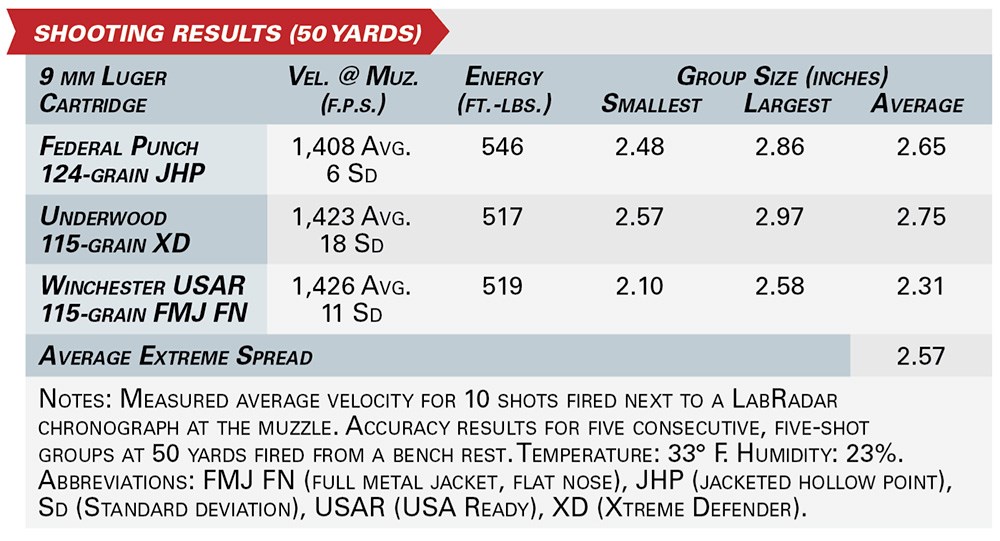
As expected, the Pivot’s levels of felt recoil were mild and easy to manage. The carbine balanced nicely and had a natural swing even though it carries a bit more weight up front due to the lightweight shoulder stock assembly. The AR-15-style sight rails provide for a familiar sight height that greatly reduces the need to hunch down to form a proper sight picture. The Pivot was outfitted with a compact Primary Arms SLx 1X MicroPrism green-illuminated optic, which proved to be a top-notch fit for the platform. Accuracy was comparable to other 9 mm PCCs when firing five, five-shot groups at 50 yards from a bench rest. Individual groups ranged from 2.10" to 2.97" in size, with an average extreme spread of 2.57".
Building a well-balanced folding long gun can be a tricky business. Ideally, it will have three general qualities going for it. First, it needs to meet the functional requirements expected of guns in its caliber and class, including accuracy, reliability and a satisfactory feature set. Next, it should be ruggedly built with a mechanism that can stand up to regular use. Finally, it should be as comfortable to use as possible. Although some takedown rifle designs sacrifice shootability in favor of function and form, the Pivot successfully brings all three qualities to the table with positive results. This 9 mm PCC will not be everyone’s cup of tea, but it proved to be more shootable than its utilitarian appearance may imply. Its Glock-like grip and controls, along with the AR-height optics configuration, gives this unusual rifle an unexpectedly familiar feel. Due to its quality construction and unique components, the Pivot has a suggested retail price of $1,795.
So, if you are looking for “something completely different,” then the Pivot is well worth the investment.